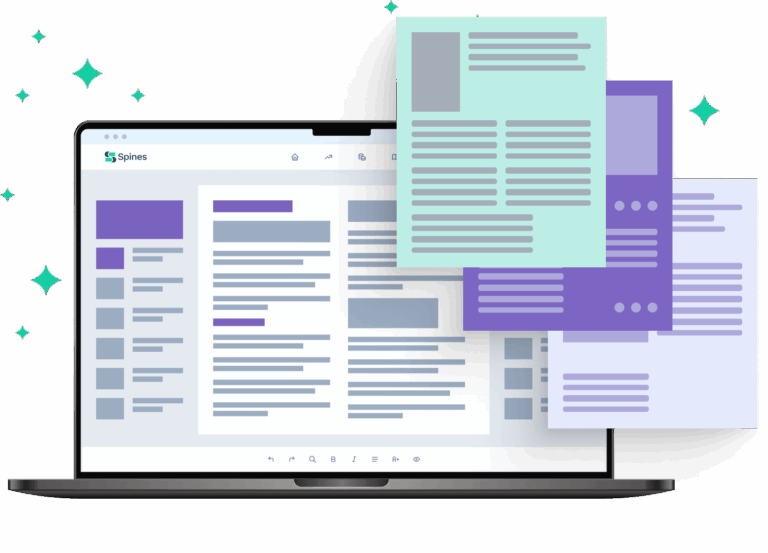Formatting Your Book - Book Formatting
Read Between the Lines: Your Vision, Perfectly Formatted for Every Page
Transform your manuscript into a polished, publication-ready book with Spines. Our AI-powered formatting tools, combined with expert human guidance, ensure your book is optimized for print, digital, and audiobook platforms.
Enjoy a seamless, fast process that keeps you in control, with personalized support at every step to make your book stand out worldwide.

- 7-Day Money Back Guarantee
- Copyright & ISBN Certificate
- Retain 100% of Your Book Rights

2,800+ AUTHORS


Book Formatting Services: Every Detail Done Right
Precision in Every Detail
Reader-Friendly Layouts
Flexible Formatting Options
Expert Collaboration
Multi-Format Compatibility
Comprehensive Genre-Specific Formatting
How to Format Your Book Like a Pro

How to Self Publish Your Book Successfully
Proper formatting is the backbone of a successful book. A well-formatted manuscript looks professional, ensures a seamless reading experience, and meets industry standards. Follow these 7 steps to get your book publication-ready:
1. Set Up Your Document
Start with a clean DOCX file to minimize errors and ensure platform compatibility.
- Page size: Common options include 6″ x 9″ for paperbacks (Amazon KDP requires 24–828 pages).
- Margins: Leave enough space for binding and readability.
- Fonts: Legible choices like Times New Roman or Garamond.
- Line spacing: 1.15 or 1.5 for optimal readability.
2. Structure Your Content
Organize your book into clear sections:
- Front matter: Title page, copyright page, dedication.
- Body text: Consistent chapter headings and alignment.
- Back matter: Acknowledgments, author bio, references.
3. Format Headers and Footers
Add professional touches with page numbers (bottom center or outer corners) and headers (chapter or book title). Exclude headers/footers on the first page of each section.
4. Apply Consistent Styles
Use your word processor’s styles feature for headings, body text, captions, and quotes. Avoid manual formatting to maintain uniformity.
5. Optimize Readability and Aesthetic Appeal
Break up large text blocks with subheadings or white space. Use bold/italics sparingly. Maintain consistent paragraph indentation and avoid widows/orphans.
6. Review and Test Your Formatting
Use print previews and test digital formats (EPUB, MOBI) on multiple devices. Verify hyperlinks function correctly.
7. Export and Finalize Your Book
Export print-ready PDFs with correct resolution and bleed settings, and eBook files compatible with Kindle and other platforms. Backup your final manuscript in multiple formats.
Tips for Success
- Proofread thoroughly to avoid distracting formatting errors.
- Test print a single copy to confirm layout accuracy.
- Seek feedback from trusted readers or professionals.
Publishing Excellence Every Step of the Way
Book Cover Design
Premium Book Printing
Book Editing

Your Story Deserves a Global Audience








Book Formatting Made Simple: Expert Insights

How to Format Your Book: 10 Essential Tips for a Professional Finish

Top Tools for Formatting Your Book

Book Format Conversion: Simplifying the Process for Authors
Comprehensive Support, Every Step of the Way
Count on our dedicated 24/7 customer support to provide expert guidance and swift solutions, ensuring you’re never alone in your publishing journey.



2,800+ Authors Have Published Their Books With Spines
The quality of their work exceeded my expectations, and their commitment to excellence was evident at every stage. While no process is without its challenges, Spines Publishing handled everything with patience and expertise, making the journey smooth and rewarding.
Author Daniel Solomon
D
There is no other company on the face of the planet that’s going to put themselves in your shoes every step of the way, and go out of their way to make sure not only that you are successful, but that you, as a published author, develop a backbone!
Author Melvin Shoales
M
I had the most phenomenal and pleasurable experience working with Isabel. Every request that I had made was met with a delightful spirit and the willingness to help me win the day. I am overwhelmed with her devotion and leadership… What a spectacular team member under the realm of Spines.
Author Hikeem Wallace
H
Spines can take the idea you are passionate about and facilitate bringing it into reality. Everyone was not only helpful but very encouraging in the entire creative process. I highly recommend Spines as the best publishing service available to all aspiring authors who would like to touch the world with their thoughts.

Author Deandre Jefferson
Isabel and the rest of the team were supportive and patient as I worked through the process. Ready to tackle book #2!!!

Author Glenn Diehll
OMG, Wardah has done it again!! My second book looks incredible on the inside and out! I love Wardah’s professionalism and how she constantly kept me in the loop and was quick to correct any changes necessary to make the book exactly what I envisioned.

Author Josanne Stewart
I am happy to recommend Spines and my project manager Wardah as the best in the industry! Authors, while considering publishing, STOP looking and choose Spines!

Author Kirk Anthony Floyd
If you are a first-time author like myself, Spines is the publishing company you need!
Author Nikodeme Mentor
N
I want to take this opportunity to thank the staff at Spines Publishing, especially Eli Nazari. You have made a lifelong dream come true: becoming an author. I look forward to working with you on my second book. God bless!

Author Terry Parker
I continue to be very impressed with Spines. From onboarding with Adriano to my account manager Wardah, they were very thorough and communicative every step of the way. They do set you up to succeed! I would recommend this team to anyone.

Author D Lawson
My production manager, José Uzcátegui, was extremely helpful and a pleasure to work with; he was incredibly involved and called with updates every week. He was just as excited as me to have my book out!
Author Lisette Conti
L
It was a true partnership. I couldn’t have asked for a better team to collaborate with on this journey. Thank you for championing my story and for the incredible work you do in amplifying diverse voices.

Author Leeora Benjamin
The enthusiasm and encouragement from Spines is incredible. My account managers Andres Herrera and Isabel Bullrich helped me through the entire process, made me feel welcomed, encouraged me to ask questions, and ensured that my novel would remain true to my vision.
Author Bironi Mikell
B
Blown away!! My mind is BLOWN. The process was so simple—from the vision being captured to the book now LIVE! Writing a book I thought was a dream, but now it’s a reality. THANK YOU, at a loss for words!

Author Natasha BarShalom White
Karla Leon at Spines could not have been more helpful. She was attentive and quick, turning around my comments in a day (if not in a few hours). I could not be happier.

Author Lawrence Bloom
I HIGHLY recommend them to any author, whether you are new or not. Ela Nazari, my production manager, was very professional, patient and amazing to work with. I am very difficult and persistent and Ela could manage me… Ela, more books are coming for you to publish!
Author Delores Coleman
D
I sent my book to 17 different publishers and got rejected every time, and vanity publishers quoted me between $11k-$17k. With Spines, I got my book published in less than 30 days!

Author Carlos Andromeda
I’ve paid over $3,500 for editors in the past, and I felt like they changed my book! With Spines, I had complete creative control over how my book turned out.

Author Joshua Holton
I’m a total beginner when it comes to computers, but I managed to design a professional-looking cover with Spines in just 3 minutes!

Author Valerie Price
My proofreading process used to take months, and I had to hire 3 freelancers. With Spines, I can do it in a single day.

Author Bradley Matthews-Middleton
Frequently Asked Questions - Book Formatting
-
We provide step-by-step guidance, personalized support, and 24/7 customer service to help first-time authors navigate formatting with ease. Our platform’s intuitive interface combined with expert advice means you’re never alone during the process.
-
Beyond formatting, we offer cover design, custom book printing, professional editing, and distribution services. Plus, every book format comes with an ISBN and copyright certificate, making your publishing journey smooth from start to finish.
-
Yes, we format books specifically for print (paperbacks, hardcovers) and digital platforms (eBooks in EPUB, MOBI formats). We also accommodate genre-specific formatting needs such as children’s books or illustrated titles.
-
Definitely. Our formatting process includes multi-format compatibility to produce print-ready PDFs, as well as eBooks in EPUB and MOBI, ready to publish on Amazon KDP, Apple Books, Kobo, and other major retailers.
-
Yes, revisions are allowed. Minor changes can be made easily on your dashboard. For major post-publication updates, there may be a small fee. Our team is always ready to support you in keeping your book up-to-date.
-
We can format a wide variety of books including novels, nonfiction, children’s books, graphic novels, and illustrated titles. If your book has special formatting needs, just reach out—we’ll work with you to deliver the best result.
We’re here to help
Ready to share your story? Tell us what you need — we’ll help bring your book to life


Join Thousands of Writers Who Became Published Authors

